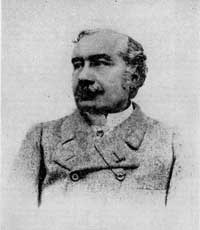<Back to Index>
- Chemist Paul Émile François Lecoq de Boisbaudran, 1838
- Composer Giacomo Carissimi, 1605
- Field Marshal Karl Philipp Fürst zu Schwarzenberg, 1771
PAGE SPONSOR

Paul Émile (François) Lecoq de Boisbaudran (18 April 1838 – 28 May 1912) was a French chemist born in Cognac. During 1858 he joined the family winemaking business, but a year later was working as a chemist.
During 1874 he wrote Spectres lumineux: spectres prismatiques et en longueurs d'ondes destinés aux recherches de chimie minérale (English: Luminous spectra: prismatic spectra and in lengths of waves intended for the searches for inorganic chemistry), which was published in Paris by Gauthier - Villars and was one of the first descriptions of the new science of spectroscopy developed by Kirchhoff. During 1875 he used this method to discover the element gallium, which he named after the Latin word for Gaul, Gallia. He found the metal in a sample of zinc ore from the Pyrenees. A year later he isolated the element by electrolysis. It was later claimed that Lecoq had named the element after himself, since gallus is the Latin translation of the French le coq, but Lecoq denied this in an article of 1877. The existence of gallium had been predicted during 1871 by Mendeleev, who called it eka-aluminium, and its discovery was a boost for Mendeleev's theory of the periodic table. Later Lecoq discovered samarium (1880) and dysprosium (1886). He also isolated gadolinium during 1885, which had been discovered during 1880 by J.C. Galissard de Marignac.
Lecoq contributed more to the development of the periodic classification of elements by proposing, soon after its discovery, that argon was a member of a new, previously unsuspected, chemical series of elements, later to become known as the noble gases.
He died in Paris at the age of 74 years.